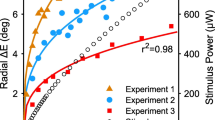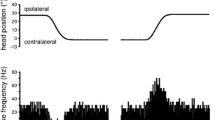Summary
The responsiveness of floccular Purkinje cells to head oscillations was examined in alert pigmented rabbits subjected to adaptation of horizontal vestibulo-ocular reflex (HVOR) under three different combinations of turntable and screen oscillations. Purkinje cells involved in the HVOR control (H-zone cells) were identified by local stimulation effects that induced horizontal eye movements. In control states, simple spike discharages of H-zone cells were modulated predominantly out of phase with the velocity of sinusoidal turntable oscillation (0.1 Hz, 5° peak-to-peak). A sustained 180° outphase combination (5° turntable and 5° screen oscillation) was found to increase the average HVOR gain by 0.16, at which point the majority of H-zone cells increased the outphase simple spike modulation. A sustained inphase combination (5° turntable and 5° screen oscillation) decreased the average HVOR gain by 0.09, with the majority of H-zone cells decreasing the outphase simple spike modulation or becoming converted to the inphase modulation. With a vision-reversal combination (5° turntable and 10° screen oscillation), there was no change in the gain of the HVOR, but a moderate advancement in the phase. In this case, H-zone cells showed no appreciable changes in their simple spike modulation. Complex spike discharges of all H-zone cells tested were modulated in response to optokinetic stimuli involved in the combinations of turntable and screen oscillations. These results support the hypothesis that H-zone cells adaptively control HVOR dynamic characteristics through modification of mossy fiber responsiveness to head oscillation under influences of retinal error signals conveyed by climbing fiber afferents.
Similar content being viewed by others
References
Balaban DC, Watanabe E (1984) Functional representation of eye movements in the flocculus of monkeys (Macaca fuscata). Neurosci Lett 49: 199–205
Batini C, Ito M, Kado RT, Jastreboff PJ, Miyashita Y (1979) Interaction between the horizontal vestibulo-ocular reflex and optokinetic response in rabbits. Exp Brain Res 37: 1–15
Collewijn H, Winterston BJ, Dubois MFW (1978) Optokinetic eye movements in albino rabbits: inversion in anterior visual field. Science 199: 1351–1353
Dufossé M, Ito M, Miyashita Y (1977) Functional localization in the rabbit's cerebellar flocculus determined with relationship with eye movements. Neurosci Lett 5: 273–277
Dufossé M, Ito M, Jastreboff PJ, Miyashita Y (1978) A neuronal correlate in the rabbit's cerebellum to adaptive modification of the vestibulo-ocular reflex. Brain Res 150: 611–616
Ekerot C-F, Kano M (1985) Long-term depression of parallel fibre synapses following stimulation of climbing fibres. Brain Res 342: 357–360
Fukuda J, Highstein SM, Ito M (1972) Cerebellar inhibitory control of the vestibulo-ocular reflex investigated in rabbit IIIrd nucleus. Exp Brain Res 14: 511–526
Ghelaruducci B, Ito M, Yagi N (1975) Impulse discharges from flocculus Purkinje cells of alert rabbits during visual stimulation combined with horizontal head rotation. Brain Res 87: 66–72
Gonshor A, Melvill-Jones G (1976) Short-term adaptive changes in human vestibulo-ocular reflex arc. J Physiol (Lond) 256: 381–414
Ito M (1970) Neurophysiological aspects of the cerebellar motor control system. Int J Neurol 7: 162–176
Ito M (1972) Neural design of the cerebellar motor control system. Brain Res 40: 81–84
Ito M (1974) The control mechanisms of cerebellar motor system. In: Schmitt FO, Worden FG (eds) The neuroscience third study program. MIT Press, Massachusetts, pp 293–303
Ito M (1984) The cerebellum and neural control. Raven Press, New York
Ito M (1989) Long-term depression. Ann Rev Neurosci 12: 85–102
Ito M, Miyashita Y (1975) The effects of chronic destruction of inferior olive upon visual modification of the horizontal vestibulo-ocular reflex of rabbits. Proc Jpn Acad 51: 716–720
Ito M, Shiida T, Yagi N, Yamamoto M (1974a) A visual influence on rabbit horizontal vestibulo-ocular reflex presumably effected via the cerebellar flocculus. Brain Res 65: 170–174
Ito M, Shiida T, Yagi N, Yamamoto M (1974b) The cerebellar modification of rabbit's horizontal vestibulo-ocular reflex induced by sustained head rotation combined with visual stimulation. Proc Jpn Acad 50: 85–90
Ito M, Nisimaru N, Yamamoto M (1977) Specific patterns of neuronal connections involved in the control of the rabbit's vestibulo-ocular reflexes by the cerebellar flocculus. J Physiol (Lond) 265: 833–854
Ito M, Jastreboff PJ, Miyashita Y (1979) Adaptive modification of the rabbit's horizontal vestibulo-ocular reflex during sustained vestibular and optokinetic stimulation. Exp Brain Res 37: 17–30
Ito M, Miyashita Y, Jasreboff PJ (1982) Specific effects of unilateral lesions in the flocculus upon eye movements of albino rabbits. Exp Brain Res 45: 233–242
Ito M, Sakurai M, Tongroach P (1982) Climbing fibre induced depression of both mossy fibre responsiveness and glutamate sensitivity of cerebellar Purkinje cells. J Physiol (Lond) 324: 113–134
Jastreboff PJ (1979) Evaluation and statistical judgment of neural responses to sinusoidal stimulation in cases with superimposed drift and noise. Biol Cybern 33: 113–120
Kawaguchi Y (1985) Two groups of secondary vestibular neurons mediating horizontal canal signals, probably to the ipsilateral medial rectus muscle, under inhibitory influences from the cerebellar flocculus in rabbits. Neurosci Res 2; 434–446
Lisberger SG (1988) The neural basis for motor learning in the vestibulo-ocular reflex in monkey. Trends Neurosci 11: 147–152
Lisberger SG, Fuchs AF (1978) Role of primate flocculus during rapid behavioral modification of vestibulo-ocular reflex. I. Purkinje cell activity during visually guided horizontal smooth-pursuit eye movements and passive head rotation. J Neurophysiol 41: 733–763
Maekawa K, Simpson JI (1973) Climbing fiber responses evoked in the vestibulocerebellum of rabbit from visual system. J Neurophysiol 36: 649–666
Maekawa K, Takeda T (1976) Electrophysiological identification of the climbing and mossy fiber pathways from the rabbit's retina to the contralateral cerebellar flocculus. Brain Res 109: 169–174
Miyashita M, Nagao S (1984) Analysis of signal content of Purkinje cell responses to optokinetic stimuli in the rabbit cerebellar flocculus by selective lesions of brainstem pathway. Neurosci Res 1: 223–241
Nagao S (1983) Effects of vestibulocerebellar lesions upon dynamic characteristics and adaptation of vestibulo-ocular and optokinetic responses in pigmented rabbits. Exp Brain Res 53: 36–46
Nagao S (1984) Adaptive changes of floccular Purkinje cell responsiveness induced by sustained optokinetic and vestibular stimulation in pigmented rabbits. J Physiol Soc Jpn 46: 182
Nagao S (1988a) Behavior of floccular Purkinje cells correlated with adaptation of optokinetic eye movement response in pigmented rabbits. Exp Brain Res 73: 489–497
Nagao S (1988b) Eye velocity and position response of rabbit floccular Purkinje cells in the horizontal eye movement field (H-zone). Neurosci Res Suppl 7: S101
Nagao S (1989) Role of cerebellar flocculus in adaptive interaction between vestibulo-ocular reflex and optokinetic eye movement response. Exp Brain Res 77: 541–551
Nagao S, Ito M, Karachot L (1985) Eye field in the cerebellar flocculus of pigmented rabbits determined with local electrical stimulation. Neurosci Res 3: 39–51
Sato Y, Kawasaki T (1984) Functional localization in the three floccular zones related to eye movement control in the cat. Brain Res 290: 25–31
Watanabe E (1985) Role of primate flocculus in adaptation of the vestibulo-ocular reflex. Neurosci Res 3: 20–38
Waespe W, Cohen B, Raphen T (1985) Dynamic modification of the vestibulo-ocular reflex by the nodulus and uvula. Science 228: 199–202
Yamamoto M, Shimoyama I (1977) Differential localization of rabbit's flocculus Purkinje cells projecting to the medial and superior vestibular nuclei, investigated by means of horseradish peroxidase retrograde axonal transport. Neurosci Lett 5: 279–283
Author information
Authors and Affiliations
Rights and permissions
About this article
Cite this article
Nagao, S. Behavior of floccular Purkinje cells correlated with adaptation of vestibulo-ocular reflex in pigmented rabbits. Exp Brain Res 77, 531–540 (1989). https://doi.org/10.1007/BF00249606
Received:
Accepted:
Issue Date:
DOI: https://doi.org/10.1007/BF00249606




